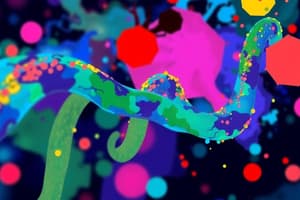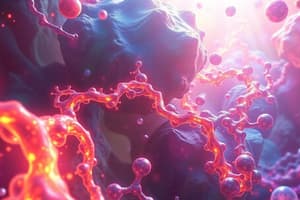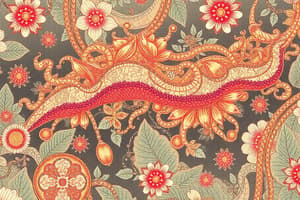Podcast
Questions and Answers
What are the components of a DNA nucleotide?
What are the components of a DNA nucleotide?
- Deoxyribose sugar, phosphate group, adenine (correct)
- Deoxyribose sugar, nitrogen base, ribose
- Ribose sugar, phosphate group, adenine
- Pentose sugar, uracil, phosphate group
Which nitrogen base is found in RNA but not in DNA?
Which nitrogen base is found in RNA but not in DNA?
- Uracil (correct)
- Adenine
- Thymine
- Cytosine
What is indicated by a higher concentration of hydrogen ions in a solution?
What is indicated by a higher concentration of hydrogen ions in a solution?
- Higher viscosity
- Neutral pH
- Lower pH (correct)
- Higher pH
What role do sodium ions play in the body?
What role do sodium ions play in the body?
What property of water is primarily responsible for its ability to provide a cooling effect during evaporation?
What property of water is primarily responsible for its ability to provide a cooling effect during evaporation?
What happens to the rate of enzyme-controlled reactions beyond the optimum temperature?
What happens to the rate of enzyme-controlled reactions beyond the optimum temperature?
How does pH affect enzyme functionality?
How does pH affect enzyme functionality?
What is the effect of increasing substrate concentration on enzyme activity?
What is the effect of increasing substrate concentration on enzyme activity?
What occurs when competitive reversible inhibitors are present in higher concentrations?
What occurs when competitive reversible inhibitors are present in higher concentrations?
Why does increasing enzyme concentration eventually cease to affect reaction rates?
Why does increasing enzyme concentration eventually cease to affect reaction rates?
How do non-competitive reversible inhibitors affect enzyme reactions?
How do non-competitive reversible inhibitors affect enzyme reactions?
What role do ribosomes play in protein synthesis?
What role do ribosomes play in protein synthesis?
What distinguishes DNA from RNA in terms of functionality?
What distinguishes DNA from RNA in terms of functionality?
Flashcards
Enzyme Temperature Effect
Enzyme Temperature Effect
Enzyme activity increases with temperature up to an optimum point. Beyond this point, the enzyme denatures, decreasing reaction rate.
Enzyme pH Effect
Enzyme pH Effect
Enzyme activity is affected by pH. Each enzyme has an optimal pH where it works best. Changes in pH can disrupt enzyme structure, decreasing reaction rate.
Enzyme Concentration Effect
Enzyme Concentration Effect
Enzyme reaction rate increases with enzyme concentration until a certain point, where there are more available enzyme active sites than substrate molecules. Adding more enzyme beyond this point doesn't increase the reaction rate.
Substrate Concentration Effect
Substrate Concentration Effect
Signup and view all the flashcards
Competitive Inhibition
Competitive Inhibition
Signup and view all the flashcards
Non-competitive Inhibition
Non-competitive Inhibition
Signup and view all the flashcards
DNA Function
DNA Function
Signup and view all the flashcards
RNA Function
RNA Function
Signup and view all the flashcards
DNA Nucleotide Components
DNA Nucleotide Components
Signup and view all the flashcards
RNA Nucleotide Components
RNA Nucleotide Components
Signup and view all the flashcards
Water's High Latent Heat of Vaporization
Water's High Latent Heat of Vaporization
Signup and view all the flashcards
Importance of Hydrogen Ions (pH)
Importance of Hydrogen Ions (pH)
Signup and view all the flashcards
Role of Iron Ions in Hemoglobin
Role of Iron Ions in Hemoglobin
Signup and view all the flashcards
Study Notes
Enzyme-Controlled Reactions
- Temperature: Reaction rate increases with rising kinetic energy up to an optimum temperature. Above this, the enzyme denatures, reducing the rate.
- pH: pH affects enzyme shape, disrupting bonds in the tertiary structure. Different enzymes have different optimal pH levels (e.g., pepsin in the stomach).
- Enzyme Concentration: Increasing enzyme concentration initially boosts the rate by providing more active sites; however, exceeding a certain point has no further effect because substrate concentration becomes limiting.
- Substrate Concentration: An increase in substrate concentration boosts the rate as more enzyme-substrate complexes form. Further increase past a point is ineffective as enzyme concentration becomes the limiting factor.
- Competitive Inhibitors: Increasing the concentration of reversible competitive inhibitors slows the reaction by temporarily blocking active sites, preventing substrate binding.
- Non-Competitive Inhibitors: Increasing the concentration of non-competitive inhibitors slows the reaction by altering the enzyme's overall shape (not just the active site).
DNA and RNA
- Structure: Both DNA and RNA are polymers of nucleotides. Nucleotides contain a 5-carbon sugar (pentose), a nitrogenous base, and a phosphate group.
- DNA Nucleotides: Consist of deoxyribose sugar, a phosphate group, and one of the nitrogenous bases (adenine, cytosine, guanine, or thymine).
- RNA Nucleotides: Consist of ribose sugar, a phosphate group, and one of the nitrogenous bases (adenine, cytosine, guanine, or uracil).
- Function: DNA carries genetic information; RNA transfers genetic information from DNA to ribosomes for protein synthesis. Ribosomes are comprised of ribosomal RNA and proteins.
Water
- Hydrogen bonding: Water has a high latent heat of vaporization, meaning evaporation cools with minimal water loss (e.g., sweating).
- Cohesion: Strong cohesion enables efficient water transport in tube-like structures like xylem. Cohesion supports water columns, and high surface tension at the water-air boundary results.
Inorganic Ions
- Inorganic ions exist in the cytoplasm and body fluids of organisms; some are high-concentration, while others are low.
- Hydrogen ions (H+): Determine pH of substances like blood; higher hydrogen concentration, lower pH.
- Iron ions (Fe2+): Component of haemoglobin, an oxygen-carrying molecule in red blood cells.
- Sodium ions (Na+): Involved in co-transport of glucose and amino acids.
- Phosphate ions (PO43-): Component of DNA and ATP.
Studying That Suits You
Use AI to generate personalized quizzes and flashcards to suit your learning preferences.
Description
Test your understanding of enzyme-controlled reactions and factors affecting their rates. Explore how temperature, pH, and concentrations influence enzyme activity. This quiz will help reinforce key concepts in biochemistry.




